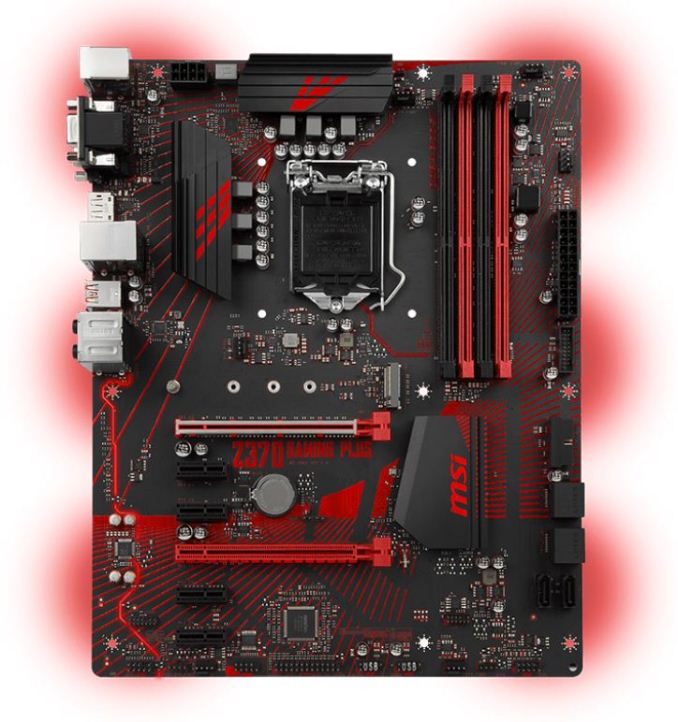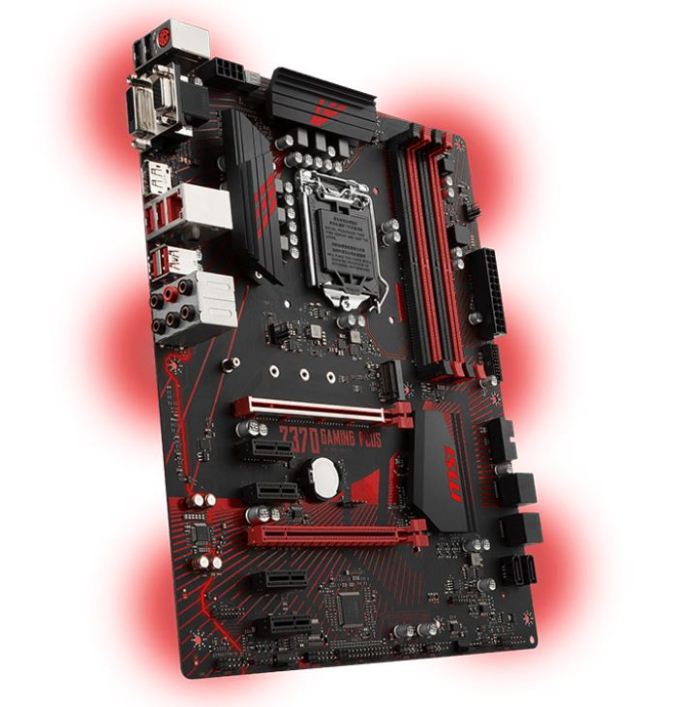Analyzing Z370 for Intel's 8th Generation Coffee Lake: A Quick Look at 50+ Motherboards
by Ian Cutress, Anton Shilov, Joe Shields & Gavin Bonshor on October 20, 2017 2:00 PM ESTMSI Z370 Gaming Plus
The Z370 Gaming Plus fits in the lower end of the MSI Z370 Gaming lineup by taking away a few key items on the other boards. Notably, the only LEDs are the board are located on the back of the board and the audio separation line; they are also only red rather than full RGB. The theme is pretty specific, being black and red, so the red LEDs do match the aesthetic. Other notable changes include full-length PCIe slot count reduced to 2, as well as the VRM section trimming a few phases. For the most part, that only excludes users who wish to run three PCIe coprocessors. Regardless of the changes, it is still a well-appointed board.
The Gaming Plus is a standout aesthetically due to its permanent black and red design. A wave of thin red lines penetrate their way through the bottom third of the board through the PCI slots and up through the VRM heatsinks, looking like a laser show, but in red only. Additionally, the memory slots alternate black and red with both full-length PCIe slots donned in red. The Gaming Plus does have one RGB LED connector in case users want to add more red, or a bit more color to their case.
The board uses four memory slots with double sided clips, supporting 64GB at maximum capacity with speeds up to DDR4-4000. The Gaming Plus has two full-length PCIe slots, with the primary slot reinforced and running a full PCIe 3.0 x16 from the processor. The second full-length slot, in red, supports x4 connectivity from the chipset, along with four black PCIe x1 slots also on the board.
The board has the normal complement of six SATA ports. Four of the ports are oriented horizontal, while the other two directly next to them are vertical to the board. Other storage options include one M.2 slot fitting up to a 110mm module, and it supports both PCIe and SSD based devices. The board is wired so that SATA1 port is disabled when an M.2 SATA SSD is installed.
Users will find six 4-pin fan headers located throughout the board. Like its family up the product stack, hybrid PWM and Voltage control functionality is retained on the Gaming Pro. Audio functionality is handled by the last generation ALC892 codec, likely in an effort to save a few dollars. Network capabilities are handled through a single Intel I219-V Gigabit LAN controller and bandwidth management software.
In another cost-saving effort, the Gaming Pro is without USB 3.1 (10 Gbps) support. Four USB 3.1 (5 Gbps) Type-A ports are found on the back panel, while four others are available through internal USB connectors. Additionally, there are six USB 2.0 ports with two Type-A located on the back panel and four more via internal connectors. Outside of the USB connectivity, the back panel IO consists of a combination PS/2 port, a trio of video outputs (DVI, D-Sub, and DisplayPort), the Intel network port, and the audio stack.













83 Comments
View All Comments
tommythorn - Monday, October 23, 2017 - link
While that feature page is great, the thunderbolt part is slightly misleading as a few of them supports it via an add-in-card. The page only lists the one that has it built-in. (The lackluster support for TB3 as well as 10 GbE is disappointing).OFelix - Saturday, October 21, 2017 - link
ThanksStochastic - Friday, October 20, 2017 - link
Would you consider putting out some simple Wirecutter-style recommendations? A lot of people (including myself) would like someone else who is better informed to simplify the decision-making process.Ian Cutress - Friday, October 20, 2017 - link
When we get our Z370 reviews underway, we'll start doing some buyers guidesStochastic - Friday, October 20, 2017 - link
Great, thanks!IGTrading - Sunday, October 22, 2017 - link
When do we get a 50+ AMD motherboard article guys ? :)abrowne1993 - Friday, October 20, 2017 - link
Okay but which one looks the coolest?dave_the_nerd - Friday, October 20, 2017 - link
"Whoever thought this was a good idea at Intel needs to be fired."Well... gee... why don't you tell us how you really feel?
DigitalFreak - Friday, October 20, 2017 - link
This whole notch thing makes me wonder if the 8xxx series was originally supposed to work in existing motherboards, but Intel ran into issues at the last minute.KaarlisK - Saturday, October 21, 2017 - link
Honestly, I cannot see the issue. The pins were changed so that nothing bad will happen if you put the wrong CPU in the wrong motherboard.As for the notches, I for one am happy that they were not changed. This means they can reuse the physical design, which lowers validation costs, which makes the CPUs cheaper.